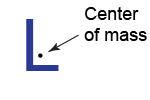|
Motion can be translational, rotational, or both. Rotating objects move about an axis of rotation that can be located either inside or outside their body. Just as a mass has inertia that resists changes in its linear motion, the same mass has rotational inertia that resists changes in its rotational motion. Angular momentum is the rotational analog of linear momentum, is expressed by the letter L, and is conserved in the absence of any net external torque. Every object has a center of mass, which can be located either inside or outside its body. Many athletes take advantage of rotation about their center of mass, and conservation of angular momentum, in performing impressive feats. 
|
|
axis, rotation, revolution, translation, rotational inertia, moment of inertia, angular momentum, linear momentum, conservation of angular momentum, center of mass
|
|
|
|
Review problems and questions |
|
- When you throw a spinning plastic disk, such as a Frisbee®, why can it fly so far without tipping over sideways?

 |
A spinning plastic disk has angular momentum. It resists tipping over, despite external forces, because its angular momentum is conserved. 
|
- The geographic center of the contiguous 48 states in the USA is the two-dimensional mean (or average) location of the land mass. How could you use a piece of poster board to locate the geographic center of the USA?

 |
Follow the procedure in Investigation 13B! Obtain a map of the contiguous states, and trace the map onto the cardboard. Cut out the cardboard to this shape. Create at least two small holes near the edge of the cardboard. Insert a pencil in each hole, hang a plumb line from it, and trace the path of the plumb line. The intersection is the geographic center of the USA
The geographic center of the lower 48 states is located several miles northwest of Lebanon, Kansas. 
|
- A tall office worker doesn’t like to lean over to reach things, so he decided to load all his files into the top drawer of his filing cabinet, leaving the other drawers empty. Is this a good or bad idea? Why?

 |
When he opens the top drawer all the way, the center of mass of the filing cabinet will be outside the front edge of its base. It will tip over! Instead, he should divide the files among all the drawers; those files in the unopened drawers will keep the center of mass within the cabinet itself. 
|
- Where is the center of mass of the letter “L” located?

 |
 
|
- Why does a tightrope walker’s horizontal pole usually droop at the ends?

 |
Because the pole droops, the combined center of mass (of the tightrope walker plus the pole) is lowered so that it is closer to the wire. When the combined center of mass is closer to the wire, there is less torque that can tip over the acrobat! 
|
- Judy is conducting an investigation by spinning washers (with a total mass of 100 g) attached to a string over her head. When the washers follow a path of 30 cm in radius, she spins them at one revolution per second.
- What is the angular velocity of the washers in radians per second?
- What is the linear velocity of the washers?
- What is the angular momentum of the washers?
- She then pulls on the string and shortens the radius at which the washers are rotating to 10 cm. What is the new angular momentum of the washers?
- What is the new angular velocity of the washers?

 |
Answer: - 2π rad/s
- 1.88 m/s
- 0.057 kg m2/s
- 0.057 kg m2/s
- 56.5 rad/s
Solution: - One revolution corresponds to an angle of 2π radians, so angular velocity is given by
- Linear velocity is calculated using
- Angular momentum is calculated as
- Angular momentum is conserved, so the new angular momentum is the same as before, or 0.057 kg m2/s.
- The change in radius causes a change in angular velocity. So we want an expression with radius r and angular velocity ω, but where all the other quantities are constant (such as mass m and angular momentum L). Take the angular momentum equation and substitute for velocity v = ωr: As a result, we see that angular velocity is inversely proportional to the square of radius, or ω ∝ 1 /r2. Since the radius is now one-third of its original value, angular velocity will be nine times its original value, or ω = 2π rad/s × 9 = 56.5 rad/s.

Take a Quiz | |

